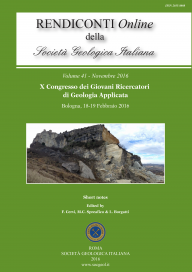
Numerical investigation of the long-term influence of seismicity on the development of the Piz Dora DSGSD (Val Müstair, Switzerland)
Federico Riva (a), Federico Agliardi (a), Giovanni B. Crosta (a) & Andrea Zanchi (a)
(a) Department of Earth and Environmental Sciences, Università degli Studi di Milano-Bicocca, Piazza della Scienza 4, 20126, Milano, Italy. E-mail: f.riva22@campus.unimib.it
Volume: 41/2016
Pages: 187-190
Abstract
The Piz Dora deep-seated gravitational slope deformation (DSGSD), located in Val Müstair (Eastern Switzerland), involves Austroalpine meta-sandstones, meta-conglomerates and phyllites folded into a slope-scale closed anticline. The surrounding area underwent significant deglaciation after the Last Glacial Maximum (LGM) and is subject to active tectonic uplifting and seismicity. While geological structure likely constrained DSGSD kinematics and size, the contribution of seismicity to rock slope instability in a deglaciating valley setting remains unclear.
Keywords
Get Full Text